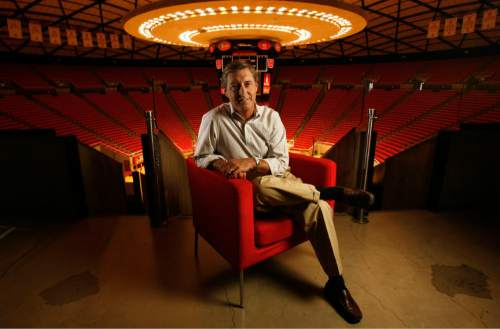This is an archived article that was published on sltrib.com in 2015, and information in the article may be outdated. It is provided only for personal research purposes and may not be reprinted.
Sixty-five representatives and 15 student-athletes from schools in the so-called Power Five conferences met last weekend in the nation's capital to exercise a newfound legislative freedom.
And freedom did ring. They voted 79 to 1 to allow for scholarships that cover the full cost of attending a university — depending on the school and its financial aid calculations, likely between $1,000 and $6,000 more annually than a current full scholarship, which covers tuition, room and board, books and fees.
But with the Power Five's choice come consequences.
Foremost among these is the "C" in what will henceforth be referred to as COA: cost.
Utah athletic director Chris Hill has been told the U.'s COA differential will be more than $3,000 per athlete and more than $1 million total because the U. — like at least a handful of Pac-12 schools — intends to provide the maximum COA to every scholarship athlete.
Hill suspects it will surprise some to learn that he doesn't have an extra $1 million lying around.
"It's a good amount of money we have," Hill said. "We're not paupers. But at the same time, we're not loaded, and it's almost impossible to get that message across."
The department budgeted roughly $8.4 million for scholarships for the latest fiscal year, and a $1 million bump would constitute a 12-percent increase.
Hill doesn't expect the U. to help offset that. The only expected increase to the athletic department's subsidy for next year would come from a 75 cent-to-$1 proposed increase in student fees — a drop in the bucket next to $1 million.
So some schools may not choose to provide COA to all athletes, or to provide the full amount (although Title IX seems to clearly dictate that schools must at least spread COA scholarships equally between genders). It's a serious blow to the bottom line.
"There may be some schools that say, 'Can we afford to do everybody?'" Hill said. "We're in that category. But we're determined that we're going to find the money, somehow."
"Somehow," given that Pac-12 Network revenues continue to be lower than initially projected, entails aggressive fundraising and conscientious spending from coaches and staff. Hill also hopes the university will prevent service costs — like the $1.6 million athletics spends to rent Rice-Eccles Stadium and the Huntsman Center — from rising faster than inflation.
There's a potential cruel irony to better compensating student-athletes for the revenue they generate: Schools may no longer be able to provide for those who do not generate revenue.
Hill said he doesn't believe the U. will be among schools to cut programs.
"My mindset is that I'm determined to figure it out," he said. "My worry is figuring it out. Can we raise the money? Can we be very cost-conscious without hurting our programs? But I think that could be a casualty of some schools around the country."
Another COA catch is its use in a program's recruiting portfolio.
Congress mandates that each financial aid office provide a cost of attendance figure to help determine financial aid, but financial aid offices have leeway.
At the U., Hill said, the amount is predominantly determined by a survey of students, and the athletics department will stay out of it. But it's unavoidable: Just as coaches already do with room and board stipends — which differ due to cost of living — a higher COA could be dangled as a carrot to lure recruits off the fence.
At USC, the COA differential will be between roughly $1,100 and $2,350, depending on the circumstances of the athlete. Another Pac-12 South school told Hill its COA gap was in the neighborhood of $1,200. Most other Pac-12 schools told The Tribune that their figures are still to be determined.
Might some schools meddle so their financial aid office gives them a competitive advantage? Sure, Hill said. But, "if I'm a president of a university, my charge is, 'Hey, gang, we've got a lot at stake with federal money coming into this university. Don't mess with it.'"
Hill's theory is that so long as facilities are up to snuff, recruits will make decisions based on the coaches, the players and having a chance to play.
COA is just a detail — albeit a pricey detail — and we save details for the small things. Big things, we choose with our hearts.
As a friend of his told him: "We get married because we're in love, we buy a house because we like the street appeal and we buy a bicycle by using Consumer Report."
Twitter: @matthew_piper —
Student-athletes surprise
Chris Hill is fairly well-versed in most of the issues discussed at last weekend's NCAA Convention, but he learned a little something from the 15 student-athlete delegates when it came time to discuss another contemporary issue: four-year scholarships.
The Pac-12 has already voted to guarantee four-year scholarships for its student-athletes, so the point was somewhat moot for Hill, but athletes from so-called equivalency sports — in which few student-athletes receive full scholarships and a total number is divided among the participants — were adamant that coaches should be allowed to nix scholarships due to poor performance.
That's a very taboo notion. Hill said it's not something administrators feel comfortable talking about, and indeed, Pac-12 Commissioner Larry Scott told The Tribune at last July's Pac-12 Football Media Days that he doesn't believe it happens in the Pac-12.
"They stood up and said, 'You know, I want to win, and if so-and-so's not carrying their weight, I don't think they should keep their scholarship,'" Hill said.
Even though he understands their reasoning, that was a surprise, he said.
Ultimately, the proposal passed anyway, with five athletes voting against it.





